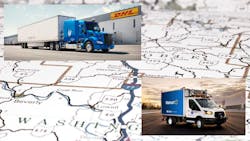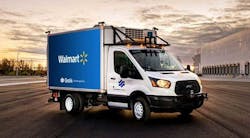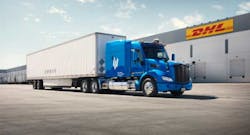Fully Driverless Deliveries is a First for Autonomous Trucking
What you'll learn:
- The autonomous-truck partnership between Walmart and Gatik.
- The Embark and Luminar partnership to create autonomous trucks, and how DHL will utilize Embark's software for its fleet.
While self-driving cars continue to capture the headlines, autonomous trucks have quietly made just as much, if not more, progress toward commercial deployment. Taken together, congestion at U.S. ports, a trucker shortage, and the rise of e-commerce have created a unique opportunity for autonomous trucking—to the point where there’s a good chance you’ll see a driverless truck in practice before a self-driving car.
To wit, consider that Walmart has begun testing self-driving delivery trucks. Walmart is working with Silicon Valley startup Gatik, a short-haul logistics company focused on autonomous delivery. Gatik says autonomous vehicles can reduce logistics costs by as much as 30% for a grocery business.
Another real-world example of the self-driving truck scenario playing out is middle-mile (transportation between fulfillment warehouses and retail stores) commercial delivery routes. There, DHL Supply Chain, the North American contract logistics arm of Deutsche Post DHL Group, has joined the Partner Development Program of autonomous-truck developer Embark. It plans to use Embark’s autonomous software for its fleet beginning in 2024. Embark’s ongoing reservation program now counts over 14,200 non-binding reservations to date. The company licenses its own software on a per-mile basis.
Walmart’s Autonomous Trucks
Let’s look at the Walmart example first. “Through our work with Gatik, we’ve identified that autonomous box trucks offer an efficient, safe, and sustainable solution for transporting goods on repeatable routes between our stores,” said Tom Ward, senior vice president of last mile at Walmart U.S.
The Walmart trucks are operated by Gatik, which has pulled the safety operator from behind the wheel of two self-driving box trucks that operate on a 7.1-mile route between a Walmart fulfillment center (or dark store) in Walmart’s home of Bentonville, Arkansas and one of its neighborhood markets. The Bentonville route offers opportunity for the trucks to prove their versatility in a range of necessary applications, including intersections, traffic signals, and merging onto densely packed roads.
Who is Gatik?
Gatik’s fully driverless operations involve consistent, repeated delivery runs multiple times per day, seven days per week on public roads. They unlock the full advantages of autonomous delivery: increased speed and responsiveness when fulfilling e-commerce orders, increased asset utilization, and enhanced safety for all road users. Gatik has five self-driving trucks operating in Arkansas.
Since commencing commercial operations in 2019, Gatik claims a 100% safety record across multiple operational sites in North America, including Arkansas, Texas, Louisiana, and Ontario. Gatik uses proprietary, commercial-grade autonomous technology said to be purpose-built for B2B short-haul logistics.
By constraining the operational design domain, Gatik has been able to achieve the safe removal of the safety driver much more quickly compared to other applications, such as passenger transportation or B2C (business to consumer) delivery.
Gatik’s deployment with Walmart in the state represents the first time that an autonomous trucking company has removed the safety driver from a commercial delivery route. “Our deployment in Bentonville is not a one-time demonstration,” said Gautam Narang, CEO and co-founder of Gatik. “These are frequent, revenue-generating, daily runs that our trucks are completing safely in a range of conditions on public roads, demonstrating the commercial and technical advantages of fully driverless operations.”
Gatik now has 25 self-driving trucks in its total fleet. Gatik uses its autonomous trucks to shuttle groceries and other goods from large distribution centers to retail locations. The company has been moving goods for Walmart in Arkansas and Louisiana, and for Loblaw Companies Limited in Ontario, Canada.
To empty the cab, Walmart had to obtain approval from the Arkansas State Highway Commission, which gave the go-ahead in December of last year. Anticipating local apprehension regarding AVs, Gatik proactively reached out to state and municipal authorities as well as emergency services to create a stakeholder engagement plan. They also intend on holding informational workshops about self-driving technology to build and maintain local buy-in.
Gatik still has safeguards in place, though. An employee sits in the passenger seat of the truck, there’s a chase vehicle, and it only operates in fair weather conditions.
DHL is Onboard
Long-haul trucks often traverse rural stretches of interstate with poor connectivity. Embark developed its technology with this in mind, ensuring an Embark-powered truck contains the hardware and software necessary for safe driving without relying on cloud connectivity.
To that end, Embark and Luminar Technologies, which specializes in automotive LiDAR hardware technology, announced a partnership to equip Embark’s truck fleet with Luminar’s long-range LiDAR. This partnership gives Embark and its carrier partners access to automotive-grade, long-range LiDAR sensors as the company progresses toward commercial deployment and delivery of its 14,200 non-binding truck reservations in 2024.
With DHL, Embark plans to work through key questions such as which DHL facilities to map directly into Embark’s coverage map to support point-to-point movements. Here, autonomous trucks may provide an opportunity to increase total miles traveled, and how to prepare the broader DHL workforce for this transformation.
With Embark Driver-equipped trucks, DHL will “prepare for and mold the deployment of autonomous trucks across its network,” said Jim Monkmeyer, President, Transportation, DHL Supply Chain. He notes, “The logistics industry relies on advanced technology solutions like automation to adapt to growing demand and increased expectations around speed.”
Determining Deployment Details
DHL and Embark conducted a detailed network analysis to begin planning for key factors in deployment, such as determining which lanes to prioritize, where delivery times could be accelerated, and calculating truck volume needs, among other considerations.
For example, automating a 600-mile trip should generate significantly more value than automating a similar 500-mile run. That’s because a 500-mile run can be completed in 10 hours manually with a single driver, while a 600-mile run could take approximately 22 hours to complete manually, assuming full compliance with federal regulation, which require a driver to take a 10-hour break after 11 hours of operation.
By considering factors such as region of operation, lane length, and frequency, Embark is able to prioritize lanes that deliver a larger savings from conversion to automation. The Embark Driver features Vision Map Fusion (VMF), Embark’s approach to mapping. It relies on a sensors-first architecture that analyzes and responds to real-time perception data as it travels down the road.
By using VMF to dynamically adapt to changes in the actual road environment rather than being constrained by a pre-mapped environment, the Embark Driver can traverse a broader set of situations on the road safely and more efficiently.
For example, Embark Driver leverages maps and previous route experience, but stays adaptable to the dynamic road environment. Instead of simply following a static map, VMF uses Embark’s patent-pending, nonlinear-optimization techniques to update the map in real time.


